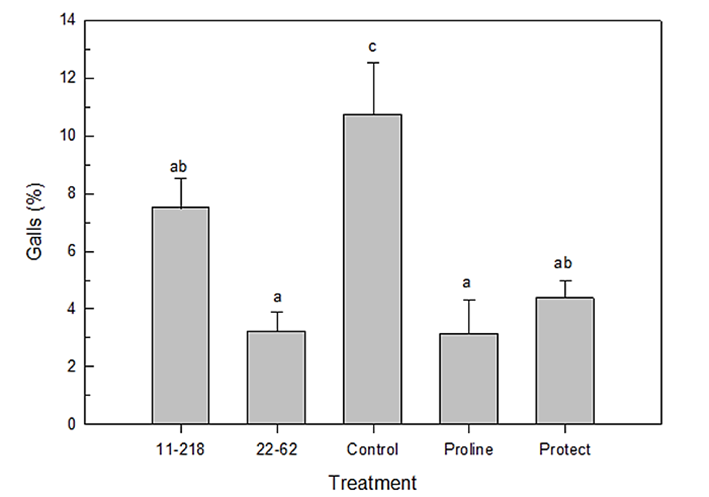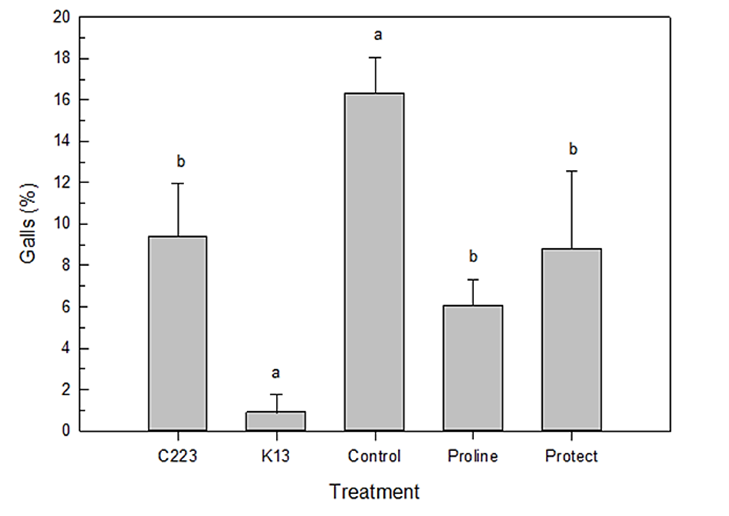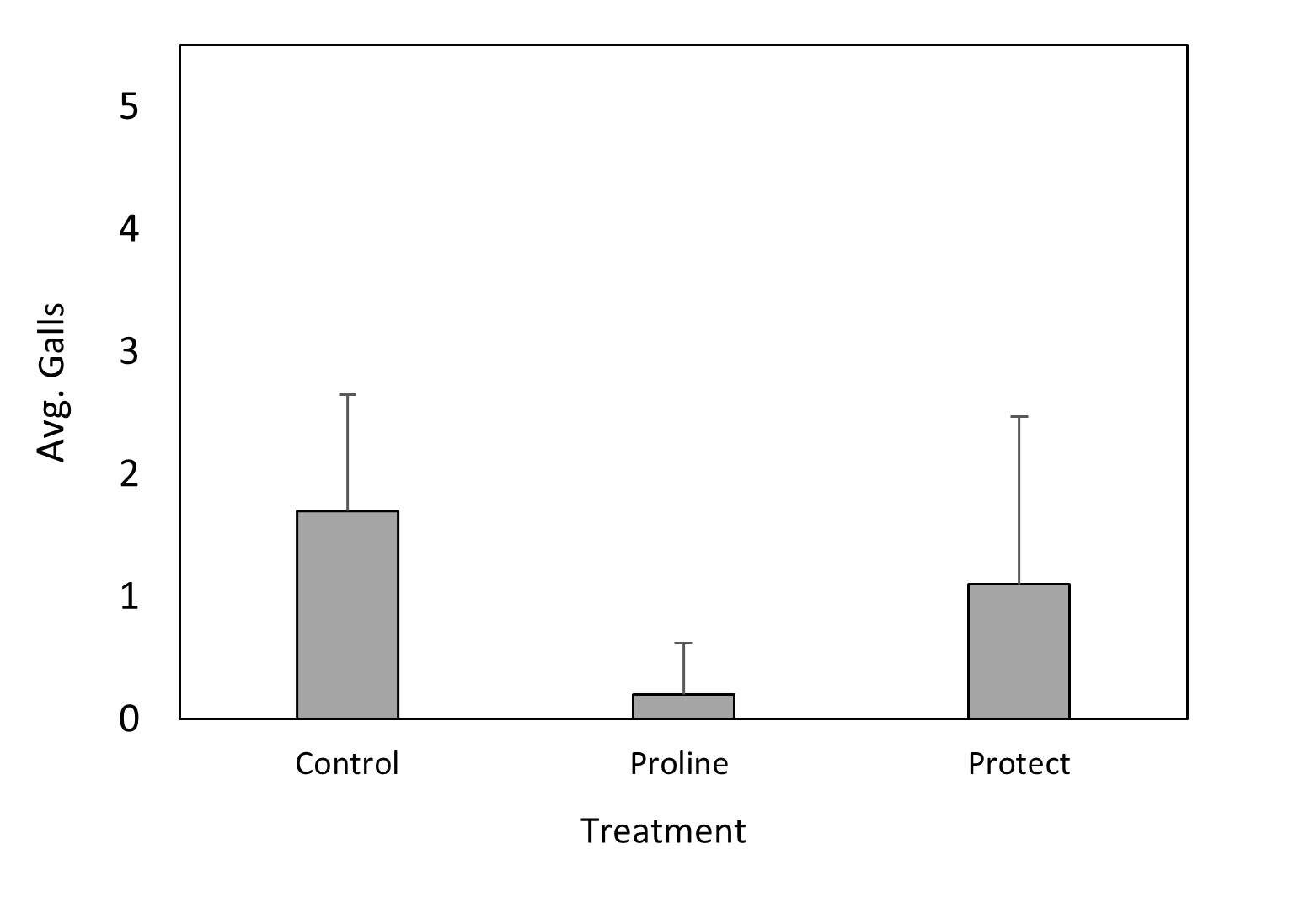Research Report 23-03 
Trials Assessing the Efficacy of a New Fungicide for the Control of Fusiform Rust Over Three Years (2020-2022)
Annakay Newell, Tom Stokes, and Nina Payne
Table 1. Seedling quality measurements of loblolly pine seedlings grown under operational conditions at the ArborGen Shellman, Georgia nursery and treated with fungicides compared to an untreated control. (*indicates a significant difference at p < 0.05).

Table 2. Seedling quality measurements of slash pine seedlings grown under operational conditions at the Arborgen Shellman, Georgia nursery and treated with fungicides compared to an untreated control. (*indicates a significant difference at p < 0.05).


Figure 1. Trial layout of fusiform rust field study at the ArborGen Shellman, Georgia nursery in 2022 under operational conditions. There were five replications of each treatment in one slash and one loblolly seedlot.

Figure 2. Incidence of rust galls on loblolly pine seedlings left untreated or treated with fungicides and challenged with basidiospores of Cronartium quercuum f.sp. fusiforme in the greenhouse in 2021. 11-218 is a susceptible and 22-62 a resistant control seedlot. (Different letters on bars indicate significant differences at p < 0.05)

Figure 3. Incidence of rust galls on slash pine seedlings left untreated or treated with fungicides and challenged with basidiospores of Cronartium quercuum f.sp. fusiforme in the greenhouse in 2021. C223 is a susceptible and K13 a resistant control seedlot. (Different letters on bars indicate significant differences at p < 0.05)

Figure 4. Incidence of rust galls on slash pine seedlings grown under operational conditions at the ArborGen Shellman, Georgia nursery in 2022 and treated with fungicides compared to an untreated control.
Introduction
Fusiform rust, caused by the fungal pathogen Cronartium quercuum f.sp. fusiforme, is an important disease of Pinus (Pine) species in the southern United States. The disease is especially damaging to Loblolly (Pinus taeda) and Slash (Pinus elliottii) pines in plantations and forest nurseries. Although cultural practices and the deployment of resistant varieties can decrease disease incidence, chemical control has proven to be the most effective in nursery production.
After the Southern Forest Nursery Management Cooperative (SFNMC) spearheaded the registration of Triadimefon (Bayleton®) for fusiform rust control in 1980, disease incidence and the number of fungicide applications needed per year decreased significantly (Carey and Kelley 1993). The SFNMC also led efforts to obtain a registration of prothioconazole (Proline®) in 2011 as both a foliar spray and seed treatment (Starkey and Enebak 2010). Since the removal of Bayleton® from the market in 2012, Proline® has been the only fungicide labelled for management of the disease. As a result, the SFNMC has been dedicated to testing new chemistries in hopes that an alternative can be identified.
In this study, we tested the efficacy of Mancozeb (Protect™DF) in controlling fusiform rust in greenhouse and field studies.
Materials and Analyses
Greenhouse Trials
In the 2020 greenhouse trial, which is documented in Research Report 20-05, there was insufficient loblolly seedling survival for conclusions to be made about the efficacy of Protect™DF. The fungicide was however found to be effective in reducing gall incidence in slash pine. A second greenhouse trial was therefore conducted in 2021. Loblolly and slash pine seeds were germinated in the greenhouse at Auburn University. At two weeks post germination, seedlings were treated with the labelled rates of Protect™DF (36.3g/1gal) and Proline® (5 fl oz/acre), and delivered to the Rust laboratory in Asheville, NC alongside an untreated control. Seedlings were then challenged with 30,000 basidiospores/ml-1 of Cronartium quercuum f.sp. fusiforme 8 weeks post germination. Internal rust laboratory resistant and susceptible control seedlots were also used for comparison.
Percent gall formation between treatments were ArcSine transformed before being analyzed as a generalized linear model (GLM) with complete block design, using SAS ver. 9.4 (SAS institute Inc.) statistical software. The Duncan’s multiple range test was used to compare the mean of all treatments with a significance level at p < 0.05.
Field Trial
After two years of testing Protect™DF in greenhouse studies, a field trial was conducted to assess how the fungicide controlled fusiform rust on loblolly and slash pine seedlings grown under operational conditions at the ArborGen Shellman, Georgia nursery. Seedlings were exposed to natural sources of inoculum as opposed to greenhouse trials where artificial inoculations are performed. The labelled rates of Proline® (5 fl oz/acre) or Protect™DF (36.3g/1gal) were applied to 40ft plots 21 days after sowing and in 5 14-day intervals after the initial application from April to June. Untreated controlled plots were also established (Figure 1). The study was initiated 21-days post sowing to ensure that protection from seed treatments with Proline® was no longer in effect.
Seedlings were collected from the ArborGen Shellman nursery at the end of the growing season, November 2022. All seedlings in counting frames were examined for galls, which indicates a rust infection. The seedling density in each counting frame was also assessed. Measurements of seedling quality that included root collar diameter (RCD), height, shoot weight, root weight and root weight ratio (RWR) were also taken. The R Statistical Software (v4.1.2; R Core Team 2021) was used to analyze significant differences between the means of each measured parameter with Tukey’s Honest Significant Difference (HSD) post hoc test. A significance level at p < 0.05 was used for comparisons.
Results and Discussion
In 2021 greenhouse studies, Protect™DF was found to be effective in reducing gall incidence on loblolly pine when compared to the control (Figure 2). There was no significant difference between the gall incidence on seedlings treated with Protect™DF and Proline® or resistant and susceptible control seedlots. There were no galls present on loblolly pine seedlings in the 2022 field trial. There were also no differences in seedling quality between treatments (Table 1). This, along with survival issues in the 2020 greenhouse trial, makes it difficult to draw conclusions about how well this product will perform against fusiform rust in loblolly pine.
In slash pine, gall incidence was significantly reduced in Protect™DF-treated seedlings when compared to the untreated control in greenhouse studies (Figure 3). In the field study, however, there was no difference in gall incidence between the two (Figure 4). Seedling quality was impacted by treatment of slash pine with both Protect™DF and Proline®, with significant reductions observed in height and RCD and an increase in RWR when compared to the control (Table 2). I describe these amounts as biologically insignificant because they are so small (0.21 mm RCD smaller and 0.90 to 1.60 cm shorter in height), especially when considering top clipping during the season.
Management Implications
1. The active ingredient Mancozeb provides sufficient control of fusiform rust on slash pine seedlings.
2. We were not able to establish how well Mancozeb controls fusiform rust on loblolly pine.
3. Seedling quality may be impacted by treatment with fungicides to treat fusiform rust.
Acknowledgements
We would like to thank the staff of the ArborGen Shellman, Georgia nursery for their assistance with this study.
References
Carey, WA and Kelley, WD. 1993. Seedling Production Trends and Fusiform Rust Control Practices at Southern Nurseries, 1981-1991. Southern Journal of Applied Forestry 17(4): 207-211.
Nadel, R. 2020. Results from the 2020 Fusiform Rust Greenhouse Trial, Testing the Efficacy of Two Potential New Synthetic Fungicides. Auburn University, Southern Forest Nursery Management Cooperative. Research Report 20-05.
Starkey, TE and Enebak, SA. 2011. The Use of Proline® (Prothioconazole) to Control Pitch Canker, Rhizoctonia Foliage Blight, and Fusiform Rust in Forest Seedling Nurseries and Efforts to Acquire Registration. National Proceedings: Forest and Conservation Nursery Associations - 2010. 65: 49-57.




